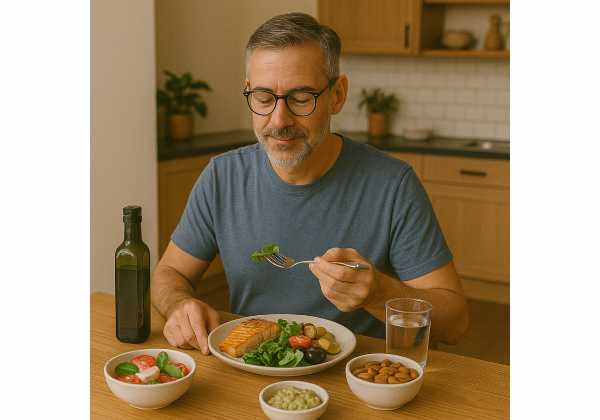
A low carb Mediterranean pattern blends two strong ideas: the cardiometabolic benefits of Mediterranean eating and the glucose-steadying simplicity of limiting refined starches and sugars. For many adults navigating midlife weight gain, rising fasting glucose, or a diagnosis such as fatty liver, this hybrid approach can provide structure without sacrificing satisfaction or social eating. In the pages below, you will learn who tends to benefit most, what foods to build around, how much carbohydrate to include, and how to avoid common micronutrient and fiber gaps. You will also find a practical one-week menu, safety considerations, and tips for transitioning in and out smoothly. If you are refreshing your overall strategy, you may also want a broader primer on patterns beyond carbohydrate: see our guide to longevity nutrition foundations for context on protein, polyphenols, and meal structure.
Table of Contents
- Who May Benefit: Metabolic Syndrome, Prediabetes, and Fatty Liver
- Core Foods: Fish, Olive Oil, Vegetables, Nuts, and Legumes
- Carb Sources and Portions: Grains, Beans, and Fruit
- Fiber and Micronutrients: Avoiding Common Low-Carb Pitfalls
- One-Week Low-Carb Mediterranean Menu
- Safety Notes and Who Should Avoid or Modify
- How to Transition In and Out Smoothly
Who May Benefit: Metabolic Syndrome, Prediabetes, and Fatty Liver
Think of a low carb Mediterranean pattern as a therapeutic dial you can turn when insulin resistance is the central problem. It is well suited to adults with:
- Metabolic syndrome. When waist size increases and blood pressure, triglycerides, and fasting glucose creep up together, reducing high-glycemic carbohydrates while emphasizing unsaturated fats and vegetables can flatten post-meal glucose and improve triglycerides.
- Prediabetes or early type 2 diabetes. Many people in this group experience pronounced post-meal spikes after bread, rice, or sugary snacks. Pairing a modest carbohydrate cap with Mediterranean staples—fish, extra-virgin olive oil, nuts, legumes, and plenty of non-starchy vegetables—can lower average glucose while preserving diet quality, satiety, and adherence.
- Fatty liver (MASLD, formerly NAFLD). The liver stores excess energy as fat. Cutting back on refined carbohydrates and added sugars (especially drinks and desserts) reduces hepatic de novo lipogenesis. A Mediterranean emphasis on olive oil, fish, legumes, and vegetables helps the liver while protecting cardiovascular risk factors.
Who else might benefit?
- Adults with high triglycerides or low HDL. Lowering refined starches and sugars often reduces triglycerides rapidly; nuts, fish, and olive oil tend to raise HDL modestly.
- People who want weight loss without rigid tracking. Building meals around protein, produce, and olive-oil-based sides naturally reduces energy density and makes portions more self-regulating.
Who might not need lower carbohydrate?
- Endurance athletes or highly active people doing long aerobic sessions may prefer more carbohydrate around training.
- Adults with normal glucose metrics who already follow Mediterranean eating may achieve similar long-term outcomes without emphasizing carbohydrate restriction.
How “low” is low carb here?
For most older adults, a sustainable target is 75–130 g carbohydrate per day (about 20–35% of energy), with the lower end often useful during the first 8–12 weeks if the goal is reversing fatty liver or addressing significant insulin resistance. Very low carbohydrate (<50 g/day) is occasionally appropriate short term, but it is not necessary for most, and it increases the risk of fiber and micronutrient gaps.
What changes first?
- Replace refined grains and sweets with vegetables, legumes, nuts, and seeds.
- Anchor meals with fish, eggs, poultry, or tofu/tempeh, and dress with extra-virgin olive oil.
- Choose berries and citrus for fruit, especially at breakfast or after protein.
For practical glucose-steadying strategies on timing and food order, see gentle blood sugar habits you can layer on top of this pattern.
Core Foods: Fish, Olive Oil, Vegetables, Nuts, and Legumes
A low carb Mediterranean plan does not mean bacon-heavy or butter-focused meals. Its heart is still Mediterranean—only the starch portion is dialed down. Build your plate from these pillars:
1) Fish and seafood (2–5 times per week).
Prioritize oily fish—salmon, sardines, mackerel, trout—for long-chain omega-3s. Aim for 100–150 g cooked per serving. On other days, include shellfish, white fish, or plant sources (tofu, tempeh) seasoned with herbs, citrus, and olive oil. Canned options (sardines, tuna, salmon) are budget-friendly and shelf-stable.
2) Extra-virgin olive oil (EVOO) as the main fat.
Use EVOO for dressing, roasting, and sautéing. A practical target is 2–4 tablespoons per day across meals. Choose robust, peppery oils for salads and milder oils for cooking. EVOO’s polyphenols complement the lower-carb template by supporting lipids and satiety.
3) Vegetables at most eating occasions.
Double non-starchy vegetables—leafy greens, tomatoes, cucumbers, peppers, zucchini, eggplant, mushrooms, brassicas. Roast trays of mixed veg with EVOO, salt, and spices to reduce prep friction. Aim for 5+ fist-sized servings daily, which helps maintain fiber despite reduced grains.
4) Nuts and seeds (a small handful daily).
Almonds, walnuts, pistachios, hazelnuts, and seeds (chia, flax, pumpkin) deliver unsaturated fats, magnesium, and plant protein. Keep portions to 25–35 g to balance calories.
5) Legumes (most days, portion-aware).
Beans and lentils are central to Mediterranean eating and remain compatible with lower carbohydrate when portioned: ½–1 cup cooked in soups, salads, or as sides. Their fiber and protein blunt glucose rise relative to refined grains.
6) Fermented dairy (optional, if tolerated).
Greek yogurt (unsweetened), kefir, and natural cheeses add calcium, iodine, and protein. Favor plain 2%–5% Greek yogurt (~170 g) with nuts and berries, or kefir (~200–250 ml) alongside eggs or veg-heavy dishes.
Flavor builders to keep it satisfying
Olives, capers, lemon, garlic, herbs (oregano, basil, mint), harissa, za’atar, and anchovies make lower-carb cooking vibrant. Keep a “Mediterranean flavor shelf” so meals never feel restrictive.
Want a deeper dive on fats, smoke points, and shopping? See our guide to healthy fats for longevity.
Carb Sources and Portions: Grains, Beans, and Fruit
Lower carbohydrate does not require eliminating all grains, beans, or fruit. It calls for choosing slower carbs and right-sizing portions around your targets.
A. Whole grains (optional, portion-controlled)
- Barley, farro, bulgur, steel-cut oats, quinoa: choose intact or minimally processed forms.
- Portion guide: ½ cup cooked at a meal (about 15–20 g carbohydrate). Combine with double vegetables and a protein.
- When to include: on more active days, especially after walks or resistance training, or when fiber intake lags.
B. Legumes (as noted above)
- ½–1 cup cooked (20–40 g carbohydrate) in a meal is typically compatible with a 75–130 g/day plan.
- Pressure-cook or soak to improve tolerance; season with EVOO, garlic, and herbs.
C. Fruit
- Favor berries, citrus, stone fruit, kiwi, and apples; limit fruit juice and dried fruit.
- Portion: 1 small piece or ¾–1 cup berries (10–20 g carbohydrate).
- Pair fruit with Greek yogurt, nuts, or eggs to slow absorption.
D. Starchy vegetables (rotational, not nightly)
- New potatoes or sweet potatoes (boiled, cooled, and reheated) can contribute resistant starch; serve ½ medium alongside a large salad and fish.
- Winter squash (roasted) at ½–1 cup portions is a flavorful alternative to grains.
E. What to limit or skip
- Refined breads, white rice, sugary cereals, pastries, and sweetened drinks.
- Ultra-processed products marketed as “keto” or “low-carb” that are low in fiber and high in additives.
Personalizing intake
Use fasting glucose, post-meal readings (60–120 minutes), and energy levels to tune portions. Many people find ~25–40 g carbohydrate per main meal and ~10–15 g at snacks works well, scaling lower on sedentary days.
For more frameworks on picking and timing carbohydrate, visit our primer on smart carbs and timing.
Fiber and Micronutrients: Avoiding Common Low-Carb Pitfalls
Lowering breads and grains can accidentally lower fiber, potassium, magnesium, iodine, and some B-vitamins—unless you plan for them. Here is how to keep the advantages of carbohydrate reduction without the downsides.
Fiber targets and tactics
- Target: at least 25–38 g/day, adjusted to tolerance.
- Vegetable base: 5+ servings of non-starchy vegetables supply 12–18 g.
- Legume lever: ½–1 cup cooked beans or lentils adds 7–15 g.
- Nuts and seeds: 25–35 g mixed nuts gives 3–4 g; 1 tbsp chia or ground flax adds 2–4 g and supports omega-3 ALA.
- Grain “booster shots”: if your fiber is short, add ¼–½ cup intact grains to a salad bowl without over-raising total carbs.
Electrolytes and hydration
Reducing refined carbohydrates often drops insulin and water retention, resulting in increased sodium and fluid losses early on.
- Fluids: 2–2.5 L/day, more if active or in heat.
- Salt to taste with mineral-rich salts unless you have a sodium-restricted condition; use olives, capers, and broth to season.
- Potassium and magnesium: emphasize leafy greens, legumes, nuts, pumpkin seeds, avocado, and yogurt. If leg cramps or fatigue occur, check intake first before considering supplements.
Calcium, iodine, and vitamin D
- Calcium: Greek yogurt, kefir, canned bone-in sardines/salmon, and leafy greens.
- Iodine: seafood and dairy; if dairy-free and low in seafood, a modest iodized salt habit helps.
- Vitamin D: food alone is often insufficient; discuss testing and supplementation with your clinician, especially in winter.
B-vitamins
Eggs, meat, fish, legumes, leafy greens, and seeds cover B12, folate, and B6. If you avoid animal foods, plan fortified dairy alternatives and consider B12 testing.
Digestive comfort
A quick fiber jump can cause bloating. Increase vegetables and legumes gradually, chew thoroughly, and cook crucifers well. If constipation appears during the first weeks, troubleshoot fiber, fluid, and activity; a tablespoon of chia or ground flax in yogurt is a gentle fix. For persistent issues, see our guide to constipation-smart adjustments.
Alcohol and sweets
Alcohol adds calories and can worsen liver fat and glucose swings. If you drink, keep it occasional and modest, and avoid sugary mixers. Dessert strategies that emphasize fruit, yogurt, and dark chocolate help you stay within carbohydrate targets; for ideas, browse our smarter desserts.
For a broader tour of fiber types and everyday sources, see fiber fundamentals.
One-Week Low-Carb Mediterranean Menu
This sample menu averages 90–120 g carbohydrate/day with 90–120 g protein/day for most adults (adjust portions to appetite, size, and goals). Each day features abundant vegetables, EVOO, and seafood or plant proteins. Use sparkling water, coffee, or tea without sugar; add lemon and herbs liberally.
Day 1
- Breakfast: Greek yogurt (170 g), chia (1 tbsp), walnuts (25 g), berries (¾ cup).
- Lunch: Tuna-white bean salad (½ cup cannellini), arugula, cherry tomatoes, olives, EVOO-lemon dressing.
- Dinner: Lemon-herb salmon (120–150 g) with roasted broccoli and eggplant; side of quinoa (½ cup cooked).
- Snack: Cucumber and feta with oregano.
Day 2
- Breakfast: Omelet with spinach, mushrooms, and goat cheese; side of orange (1 small).
- Lunch: Lentil-vegetable soup (¾ cup lentils) with side salad and EVOO.
- Dinner: Chicken thighs braised with olives, tomatoes, and artichokes; cauliflower “couscous.”
- Snack: Almonds (25 g).
Day 3
- Breakfast: Kefir (250 ml) smoothie with berries (½ cup), peanut butter (1 tbsp), and cinnamon.
- Lunch: Sardines on roasted pepper and zucchini ribbons; drizzle of EVOO and capers.
- Dinner: Shrimp and asparagus sauté with garlic and parsley; farro (½ cup cooked).
- Snack: Apple (1 small) with tahini (1 tbsp).
Day 4
- Breakfast: Cottage cheese (200 g) with sliced kiwi and ground flax (1 tbsp).
- Lunch: Greek salad with grilled chicken; sprinkle pistachios (15 g).
- Dinner: Baked cod with tomatoes and onions; side of boiled, cooled, and reheated new potatoes (½ medium) for resistant starch; large green salad.
- Snack: Carrot sticks with hummus (2 tbsp).
Day 5
- Breakfast: Poached eggs (2) over sautéed greens and cherry tomatoes; slice of whole-grain rye (½ slice, optional).
- Lunch: Chickpea-tuna tabbouleh (½ cup chickpeas) with parsley and lemon.
- Dinner: Turkey meatballs in tomato sauce over roasted spaghetti squash; side salad.
- Snack: Plain yogurt (100 g) with cocoa (1 tsp) and hazelnuts (15 g).
Day 6
- Breakfast: Skillet of peppers, onions, eggs, and feta (shakshuka-style).
- Lunch: Nicoise-inspired plate: canned salmon, green beans, olives, tomatoes, boiled egg, EVOO-mustard dressing.
- Dinner: Grilled mackerel with fennel-orange salad; quinoa (¼–½ cup cooked).
- Snack: Pear (½–1 small) with cheese (30 g).
Day 7
- Breakfast: Overnight chia-yogurt bowl with almonds and raspberries.
- Lunch: White bean and kale stew (½–¾ cup beans) with herbed EVOO.
- Dinner: Tofu and vegetable tray bake with oregano and lemon; tahini-garlic sauce; side of bulgur (¼–½ cup cooked) if desired.
- Snack: Dark chocolate (20–25 g, 70%+).
Batch-cooking shortcuts
- Roast two large sheet pans of mixed vegetables on Day 1.
- Cook a pot of lentils and a pot of quinoa/farro; freeze in ½-cup portions.
- Prepare a jar of vinaigrette (EVOO + lemon + Dijon + oregano).
If you like to prep ahead, skim our companion primer on batch cooking for longevity.
Safety Notes and Who Should Avoid or Modify
A low carb Mediterranean plan is food-forward and flexible, yet some groups need tailored supervision or adjustments.
1) Diabetes on medications
- Insulin or sulfonylureas: lowering carbohydrate can reduce insulin needs quickly. Work with your clinician to avoid hypoglycemia and to adjust doses. Keep fast-acting glucose on hand during the first weeks.
- SGLT2 inhibitors: dehydration risk rises if you cut carbohydrate and fluids aggressively. Maintain hydration and review sick-day rules.
2) Kidney disease
- If you have moderate to severe chronic kidney disease, maintain moderate protein (generally 0.8–1.0 g/kg/day unless advised otherwise) and monitor potassium and phosphorus depending on your labs. Legumes and vegetables remain valuable; your renal dietitian can tailor portions.
3) Liver disease
- For fatty liver, low carb Mediterranean is often helpful; alcohol should be minimized or avoided. If you have advanced liver disease or cirrhosis, seek specialist guidance on protein (you usually need 1.2–1.5 g/kg/day) and sodium.
4) Thyroid, bone, and menopause considerations
- Ensure adequate iodine (seafood, dairy, iodized salt) and calcium + vitamin D if dairy intake is low. Weight-bearing exercise plus sufficient protein preserves bone and muscle.
5) Digestive or gallbladder issues
- If higher fat intakes aggravate symptoms, emphasize fish, yogurt, legumes, and modest EVOO portions while you titrate tolerance.
6) Underweight, eating disorders, or frailty
- Do not reduce carbohydrate without professional care. The priority is energy adequacy and nutrient repletion.
7) Sustainability check
- You should be able to eat this way at home, at restaurants, and while traveling. If your plan feels rigid or socially isolating, adjust upward in carbohydrate from minimally processed sources and maintain the Mediterranean core.
Red flags to pause and reassess
- Recurrent hypoglycemia; persistent dizziness or lightheadedness; unintended weight loss; worsening lipid profile (especially if LDL-C rises substantially); or ongoing GI distress beyond a short adjustment period.
How to Transition In and Out Smoothly
Set your starting template (first 2–4 weeks)
- Pick a daily carb range (e.g., ~100 g/day) and spread it across meals: ~30 g at lunch and dinner, 20 g at breakfast, 10–15 g snacks if needed.
- Structure every plate: protein (palm-sized), non-starchy vegetables (at least two fists), healthy fat (EVOO/nuts/seeds), and an optional slow carb (¼–½ cup intact grains or ½–1 cup legumes or a piece of fruit).
- Implement three keystone habits:
- Veg first bites. Start meals with salad or cooked vegetables to slow glucose rise.
- Move after meals. A 10–15 minute walk or light chores improves post-meal numbers.
- Hydrate and salt to taste. Prevent early fatigue and headaches as insulin and fluid balance shift.
Re-introduce or upshift carbs when appropriate
- If fasting glucose and triglycerides normalize and weight stabilizes, increase by 10–15 g/day each week, prioritizing legumes, intact grains, and starchy vegetables. Keep dessert and refined flour rare.
- On training days, place more carbohydrate within 2 hours post-exercise to support recovery.
Cycle seasonally or around life events
- In winter, lean on legumes, canned fish, frozen vegetables, and jarred roasted peppers.
- During travel or holidays, maintain the Mediterranean base and accept modest deviations; return to your usual pattern at the next meal.
Track what matters without obsession
- Waist and weight weekly, not daily.
- Fasting glucose (and optional post-meal checks 1–2 times per week).
- Energy, sleep, and GI comfort. Small course corrections—moving a ½ cup of legumes from dinner to lunch, adding an extra salad, or trimming a nighttime snack—often restore momentum.
Commit to a maintenance identity
- Rather than “on or off,” aim for Mediterranean always, carbohydrate adjusted. You keep olive oil, vegetables, seafood, legumes, and nuts constant; you move carbohydrate portions up or down based on labs, appetite, and activity.
References
- Efficacy and safety of low and very low carbohydrate diets for type 2 diabetes remission: systematic review and meta-analysis of published and unpublished randomized trial data 2021 (Systematic Review)
- Practical Lifestyle Management of Nonalcoholic Fatty Liver Disease for Busy Clinicians 2024 (Guideline/Review)
- The effectiveness of the Mediterranean Diet for primary and secondary prevention of cardiovascular disease: An umbrella review 2025 (Systematic Review)
- Comparative Evaluation of a Low-Carbohydrate Diet and a Mediterranean Diet in Overweight/Obese Patients with Type 2 Diabetes Mellitus: A 16-Week Intervention Study 2023 (RCT)
- Standards of Care in Diabetes—2025 Abridged for Primary Care Providers 2025 (Guideline)
Disclaimer
This article provides general nutrition information and is not a substitute for personalized medical advice, diagnosis, or treatment. Always work with your healthcare professional—especially if you use glucose-lowering medications, have kidney or liver disease, or have a history of disordered eating—before making significant dietary changes. If you experience hypoglycemia, dizziness, unintended weight loss, or persistent digestive symptoms, seek medical care promptly.
If you found this guide useful, please consider sharing it on Facebook, X (formerly Twitter), or any platform you prefer, and follow us for future updates. Your support helps us continue creating reliable, practical health content.










